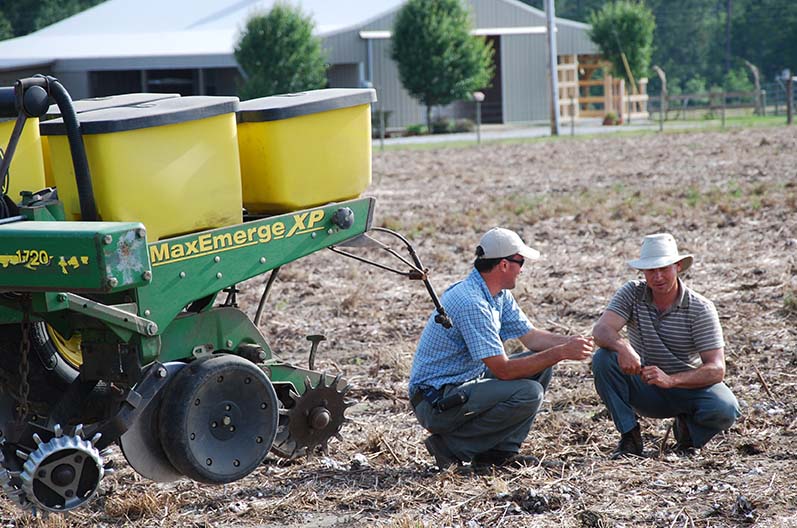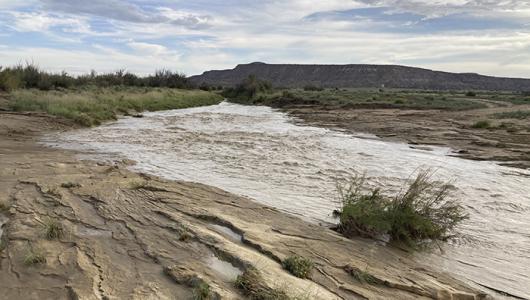Ask the Expert is a new series launching on farmers.gov. In this Ask the Expert, Joey Koptis, District Conservationist for the Natural Resources Conservation Service (NRCS) in Baldwin County, Alabama, answers a few questions about the importance of soil health.
NRCS’ motto is “helping people help the land.” One of the ways they do this is by providing technical and financial assistance to landowners who want to better manage their natural resources.
Along with his full-time duties at the office, Joey also operates a row crop operation. Improving the health and productivity of soil is a driving force in both his professional and private life.

What are some signs of healthy, productive soil?
Soil is an ecosystem that when healthy can provide nutrients for plant growth, absorb and hold rainwater, as well as filter and buffer pollutants. Below are a few indicators of healthy soil:
-
Healthy soils produce healthy plants. Think of it as a cycle; the soil feeds the plant and the plant feeds the soil.
-
Water infiltrates quicker into healthy soils after a rain event
-
Presence of earthworms
-
Higher moisture content
-
Presence of higher soil organic matter
What are some signs of poor soil quality?
If your soil quality is poor, your soil can’t adequately do its job when it comes to growing a crop or plants. Check for the following indicators of poor soil quality on your operation:
-
Poor plant health, (crops, produce, lawn grasses)
-
High ground compaction (due in large part to the lack of living plants)
-
Water infiltrates very slowly in these areas
-
No earthworms present due to compaction
How can farmers address poor soil quality?
After identifying some of the symptoms mentioned above, a good follow up is contacting your local NRCS field office. NRCS staff can help you identify potential causes for poor soil quality and offer practical solutions to help improve soil health.
Another helpful resource is your local Extension Service. They have a long history of providing formal and non-formal education on topics relevant to producers, regardless if they are rural, urban, traditional, or non-traditional.
What do you consider the most common problem when improving soil health?
Ag producers are sometimes hesitant to try new techniques like introducing cover crops or implementing no-till or reduced till practices, and they often don’t allow enough time for new practices to prove beneficial. Remember to be patient during the soil regeneration process as improvements may seem slow at first but will happen.
Can you share some practices that help improve soil health?
Your local NRCS field office can work with you to develop a conservation plan and suggest practices that fit your operation. Below are just a few examples of practices that can help build high functioning healthy soils:
-
Minimize disturbance: Work to reduce tillage, and other physical, chemical, and biological disturbances
-
Maximize Cover: Keep soil covered either with a live plant or dead litter residue
-
Maimize biodiversity: Plant diversity – adding cool season and warm season plants to your operation in the form of grasses and broadleaves, as well as livestock integration with prescribed grazing if applicable
-
Maximize living roots: Continual live plants/roots
To learn more about these practices visit farmers.gov/conserve/soil-health.
What does soil health look like on your row crop operation?
Growing up on the family farm, the only method I knew was conventional tillage. Admittedly, I did enjoy pulling the disc or chisel plow as we prepared the land for planting. It wasn’t until I attended Auburn University that I learned about different farming methods.
I remember thinking during class and the field demonstrations, “these people are crazy; this will never work in our coastal plain soils.” As the class progressed, the instructors demonstrated several soil quality tests in the field, and I quickly learned that the tillage we used on our farm was certainly not the best thing for soil quality, in fact, it was the opposite.
Now it was up to me to take the message back and convince my dad to do things different. This wasn’t an easy task, but over time my dad saw the decreased trips across the field, the fuel and fertilizer savings, and eventually increased yields would ultimately pay off.
Since we implemented conservation tillage on our farm, we have noticed a difference in our bottom line with increased profits, reduced erosion and feel like we are doing our part to conserve our most valuable resource for future generations. Soil quality will always be a top priority on our farming operation.
USDA Service Centers are open for business by phone appointment only and field work will continue with appropriate social distancing. While our program delivery staff will continue to come into the office, they will be working with our producers by phone, and using online tools whenever possible. All Service Center visitors wishing to conduct business with the FSA, NRCS, or any other Service Center agency are required to call their Service Center to schedule a phone appointment. More information can be found at farmers.gov/coronavirus.


